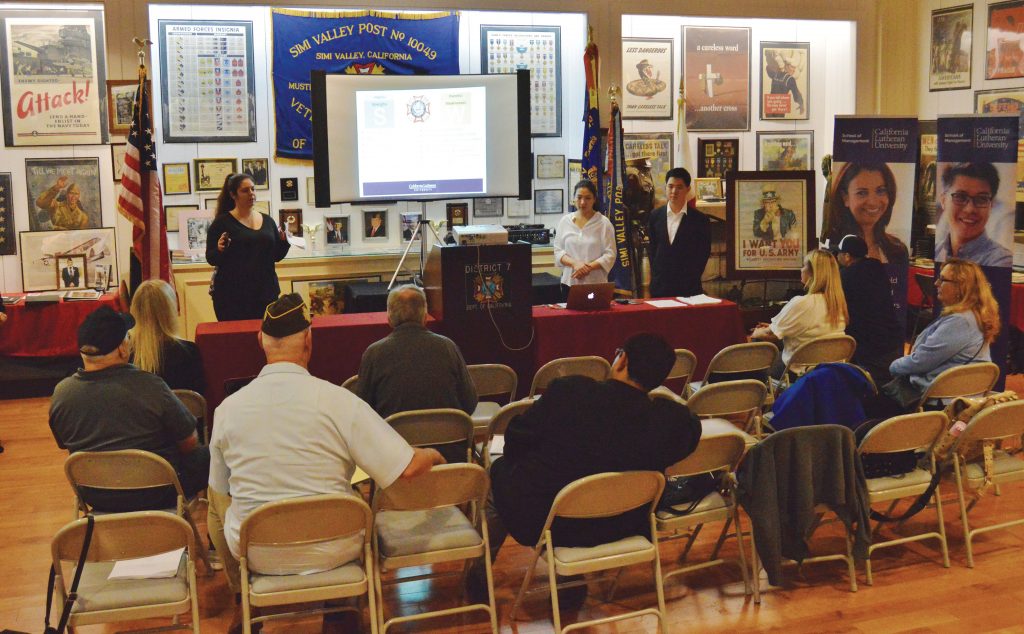CLU students apply business lessons to VFW

From left, California Lutheran University students Cressie Steketee, Yu Zhang and Krittaphat Panthong outline recruitment and retention, social media and event strategies for the Veterans of Foreign Wars Post 10049.
Simi Valley’s Veterans of Foreign Wars Post 10049 got some free business consulting Feb. 14 from graduate students at California Lutheran University, who advised rebranding and recruitment efforts to stem membership and financial losses.
After struggling to stay afloat and drum up funds to maintain its headquarters and museum facilities, the post reached out to the CLU School of Management, which incorporated the research into a capstone course for six graduate students.
The proposal had to have elements like marketing, financial and organizational design to be approved as a capstone project, said Sumantra Sengupta, director of MBA programs at the college.
“It’s intended to bring to bear all their business learning so it has to really satisfy a bunch of requirements before our students take it on,” Sengupta added.
Over 11 weeks, the students conducted an analysis of the nonprofit’s strengths and weaknesses, said Maitha Bubshait, who graduated Feb. 16, along with fellow capstone members Apinop Harulum, Cressie Steketee, Krittaphat Panthong, Jantana Promsawad, and Yu Zhang.
While the VFW has more than 200 members, only around 50 of them are active, and its headquarters needed at least $25,000 in repairs to its roof, kitchen, interior and parking space, said Junior Vice Commander and Navy veteran Mark Larson.
“We’re getting there, slowly,” said Larson, who initiated a $50,000 GoFundMe account at the students’ suggestion that had raised $350 by press time. He had also considered registering the pre-World War II building as an historical site and applying for city funds for its maintenance.
Recruiting and retaining younger veterans has also been a point of struggle for the group. At nearly 50, Larson is one of its youngest members. The leadership of the organization changes frequently, making continuity on large projects more difficult, Larson said.
“Trying to get the VFW to rebrand itself is challenging,” he said. “It’s very old fashioned, very set after the military. Every year, it changes. Every year, you get new people voted in.”
The presentation by the CLU students put a heavy focus on retention strategies, which are more time- and cost-effective than generating new members, Steketee said. The team created multi-step plans for maintaining relationships with new, active, and inactive members, prioritizing the conversion period after a free trial membership.
Social media and corporate event sponsorships could help the VFW raise money in the meantime, the students said. A social media presence would not only grab attention and strengthen relationships through interaction with followers, methods like Twitter are measureable and would help the post follow trends its members and donors are interested in while promoting the updated brand.
The VFW struggles with its image and preconceptions of who is eligible to be a member, said Navy recruiter Jim Snyder, who attended the presentation.
“It’s called Veterans of Foreign Wars and me, I never went to Afghanistan or Iraq,” Snyder said. “I spent my life in a submarine under the ocean, so I don’t really consider myself a veteran of a foreign war. I would never have even then thought to join.”
Activities and events could help the VFW attract younger veterans, the students advised, specifically a small-scale golf tournament held around Veterans Day, with help from corporate sponsors with veteran executives or a history of supporting vets.
“It had interesting demographic things that even I hadn’t thought of when they went into the project,” Sengupta said, such as targeting women and wives of veterans, who tend to donate more. “It’s more about thinking more commercially. There’s a lot of for-profits and nonprofits essentially competing for discretionary donor funds.”
The post also stands to lose its museum location in the Simi Town Center, with no feasible way to combine the headquarters and museum. It has about a year to implement funding and membership strategies, the team concluded, and could possibly have to find a new rental location where it could combine both offerings.
“The museum is kind of a unique place,” Sengupta said. “It’s kind of a draw for the local community. They need a lot more foot traffic. They have to become more relevant to the younger veterans.”
• Contact Marissa Nall at [email protected].











